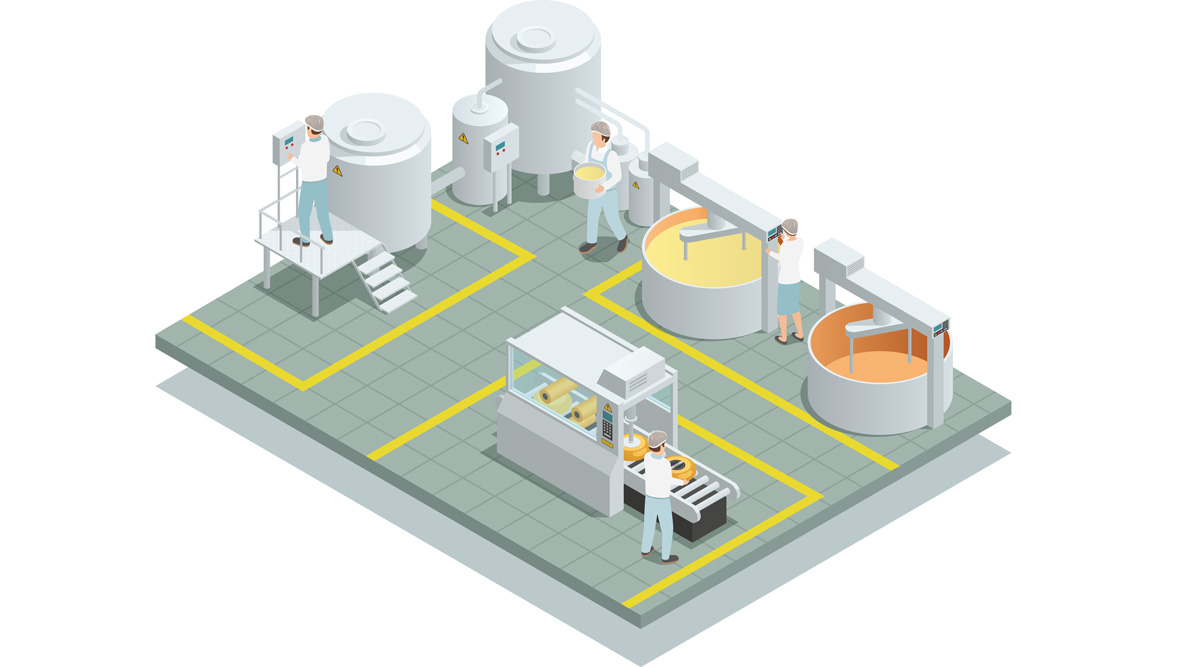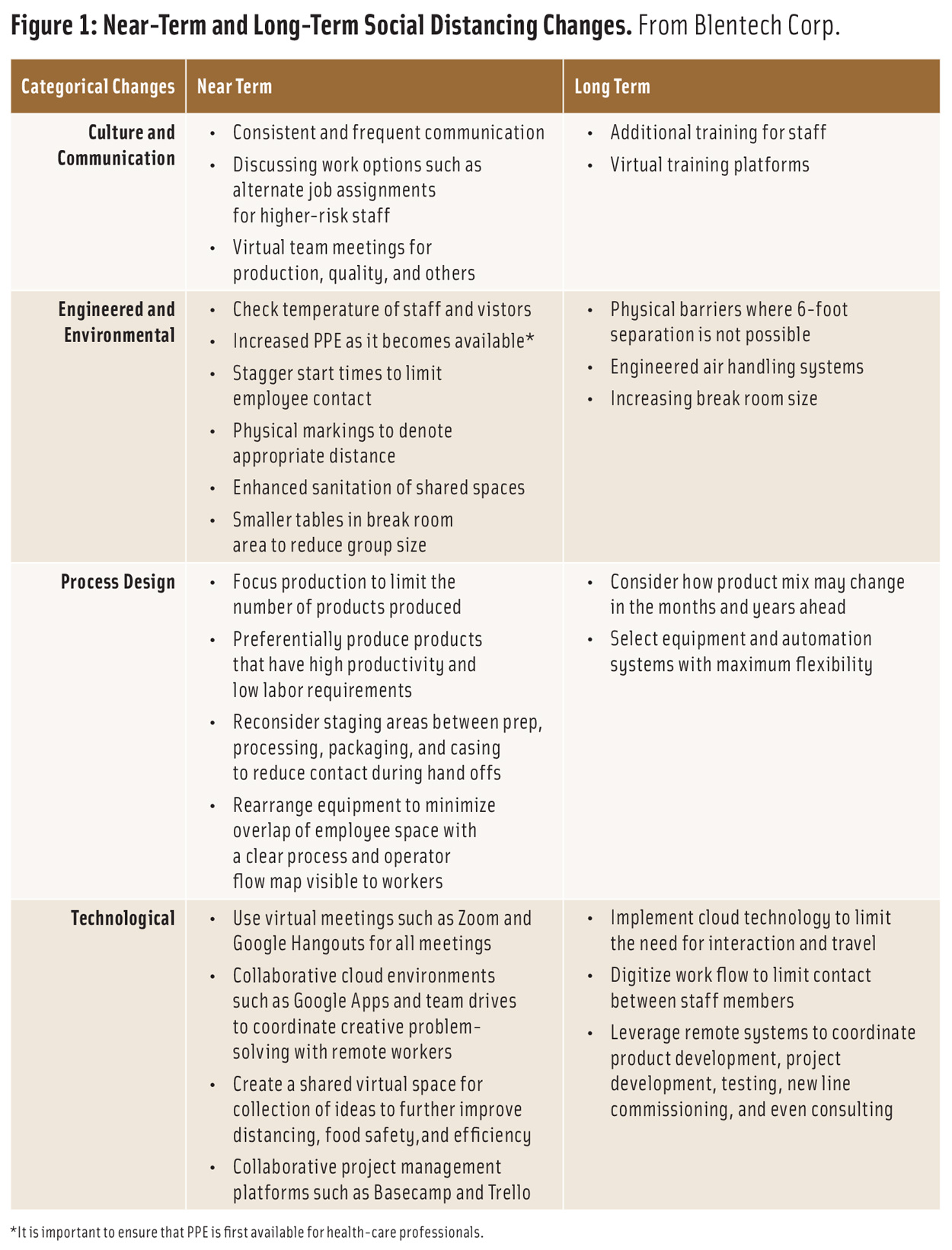Social Distancing in a Modern Food Factory
PROCESSING
The COVID-19 virus has had a seismic impact on nearly all aspects of our lives and our industry. Of course, even with shelter-in-place orders and travel restrictions, it’s clear that the food industry is undeniably essential. As evidenced by empty store shelves, consumer behavior has shifted toward shelf-stable, frozen, and other longer shelf-life foods. How enduring these changes will be remains unclear, but like other essential industries, food production must quickly adapt to this new reality and ensure that customers have reliable access to safe, nutritious, and high-quality foods.
One thing is clear: Food processors understand their purpose and have demonstrated that they are remarkably capable of agility. This is an inspiration to see in an industry that at times has been slow to change. Good manufacturing practices such as thorough hand washing, exceptional sanitation, fundamental personal protective equipment (PPE), and training have long been standard practices, which gave the industry a head start. But adaptation has not been without challenges, and implementing social distancing policies on the processing floor requires a new approach to operations. We have seen that social distancing measures currently fall into four categorical areas and are classifiable into near- and long-term changes.
Culture and Communication
The first is Culture and Communication. Dave Gardner, executive vice president of operations for Amy’s Kitchen, explained that a “people first” approach can help to make the necessary changes quicker because employees are part of the change. It also sparks the emergence of new ideas from an engaged team. Gardner explained that Amy’s philosophy of “take care of your employees, and they will take care of their customers” is truly paying dividends. Amy’s has even taken the step of purchasing a thermometer for each team member and is asking team members to check their temperatures daily and not to come in if their temperature is above 100.4˚F.
Through consistent communication, many companies are creating awareness of the importance of limiting contact, and this behavioral adaptation is a foundational component in a successful social distancing strategy. Whether by eliminating hand shaking or shifting planning meetings to virtual platforms, basic awareness limits contact. A policy stating how social distancing is applied and reinforcing the need to balance food safety and human safety is advisable to guide implementation of process, environmental, or technological changes.
Process Design
Second is Process Design. While some jobs in our industry can be done remotely, we historically have relied heavily on travel. Process design can help reduce travel and contact and allow some jobs to be handled remotely. Until the present situation, workflow, as well as process lines, were generally designed to improve efficiency by either a) increasing direct communication or b) reducing the space required for production lines. These fundamentals can be at odds with social distancing, but changes can be made with minimal effort.
While longer-term initiatives are paused for many processors, focus is being diverted into rethinking the production floor. Changes may include focusing production on products with lower labor requirements in order to keep staff density low and augmenting that with digital communication systems. Simple changes such as mapping traffic patterns on the plant floor highlight areas of concern. Once traffic patterns are better defined, personnel flow can be improved with clearly marked lanes of traffic. This is particularly valuable in product preparation areas, product staging areas, or areas for material hand- offs. In some cases, flexible conveyor systems enable rerouting product to further reduce staff density. This is particularly true in assembly and casing areas. Large-scale redesign of these areas can often require significant capital and engineering, but in other cases, we have seen companies quickly redesign workflows using basic flow-charting systems such as Lucidchart to map out process and information flows. A deeper interest in versatile processing equipment options and flexible automation is surfacing.
Engineered and Environmental Controls
The third categorical change is in Engineered and Environmental Controls. People are habitual and social. Although consistent communication helps to establish new behavioral patterns, physical changes to the environment can further limit human-to-human interaction, which helps to reduce risk on the plant floor. One powerful way to ensure contact is limited or even eliminated is through engineered and environmental controls, that is, by designing the processing floor and associated supporting systems with reduced contact in mind. Short-term controls include changes such as placing physical markings on the floor as well as installation of simple barriers.
The use and supply of PPE has been a controversial topic given the shortages that have occurred. It’s clear that PPE priority should be given to health-care workers. Some food plants already had an ample supply of masks and gloves, but others did not. Where PPE was not available, locally made face coverings such as bandanas have been deployed. Scientific evidence suggests that these offer reduced protection compared with N95 masks, but many companies are rightly pointing out that some protection is better than no protection, and other studies are suggesting some fabrics provide reasonably good protection when properly maintained, used, and washed.
Technology
The fourth category is Technology. Perhaps the most impactful of the solutions, technology offers an option to permanently reduce human-to-human interaction through enhanced plant floor automation and material handling. Many of these changes require capital investment and time, but these technologies also fall into the categories of near-term and long-term deployment options. With these business continuity issues now front and center, the case for Internet of Things (IoT) technology has never been clearer. Projections for how long social distancing will remain a standard practice vary, but many experts agree that it could be with us for a long time. As near-term solution implementation is achieved, scoping longer-term solutions will help processors reduce risk in their options.
When long-term improvements involve capital investments, scoping new equipment and technology may seem challenging without travel. Shannon McLarty at Blentech’s Innovation Center in Santa Rosa, Calif., has implemented virtual testing and demonstrations for customers with new and existing recipes for the proof of process companies need to get peace of mind through proof of concept. This type of framework can be applied in any aspect of product or process development using technological shifts. Consider the following:
1) Most human-to-human interaction in food plants occurs to either exchange information or exchange products. Not unlike the early stages of preparing a HACCP plan, a team can reconsider their process flows to assess where technology can reduce points of contact.
2) To leverage process and engineering experts, companies can quickly implement the ability to develop processes and products as well as scale up with limited or no travel. This can be accomplished with remote systems as simple as Google Hangouts or Zoom or with more elaborate technologies.
3) For new equipment installations required to increase capacity, processors can minimize the number of people in the plants by purchasing pre-skidded, pre-automated equipment with preconfigured piping, etc.
4) Automatic recipe and batch control systems can be retrofitted onto existing lines or supplied with new equipment. These automatic systems typically require less interpersonal communication and enable a company to continue operations if a key staff member is asked to self-isolate.
Easily deployable technology is available to address working areas impacted by high staff density or significant human-to-human interface. Working within your supplier ecosystem and trade organizations to share best practices and build on ideas that add real value will allow faster adaptation.
Seismic shifts require rapid response, but technology offers exceptional opportunities to adapt to these new conditions. Remote monitoring and communication technologies have been in development for years, but cultural bias toward human-to-human interface has slowed adoption. More collaborative remote experiences than standard Zoom meetings can easily be configured using other innovative technologies. The food industry is often supported by experts who assist in product development and process design as well as maintenance and engineering, and these new technologies can add real value in these areas. These teams can still be accessed without using these novel technologies. For example, working with support and engineering staff with technologies such as RealWear Zero-Touch remote communications apps can enable an expert to get a “boots on the ground” assessment of a process floor without setting foot in the building. Cloud systems that enable remote monitoring and record keeping using IoT technologies that also enable the digitizing of batch process information help companies stay aligned when they have multiple plant operations or rely on co-packers for production demand. (Additional observations are compiled in Figure 1).
As an industry we are quickly learning new ways to protect our people and ensure our food processing systems operate safely and efficiently. Many of these changes will be enduring, and changes in each of these four categories are important for success in the future.






